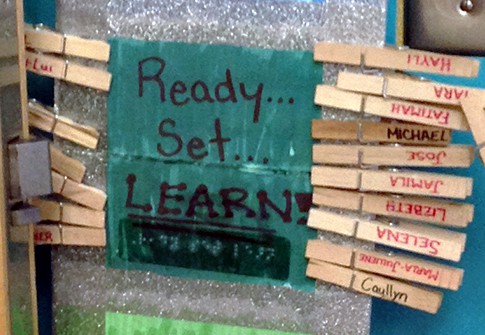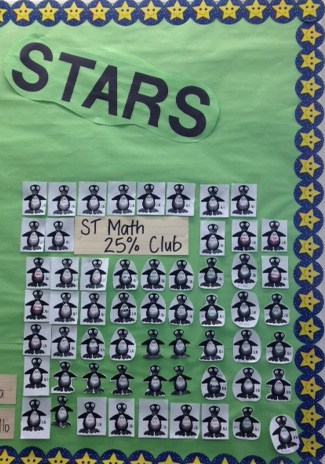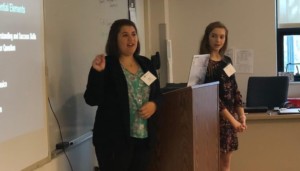Blended Learning Decisions in Action

“The objective here is to find multiple ways to show the same problem.” This a third grader explaining his work to me — A third grader!
Thanks to an invitation from Midway Elementary School Principal Rebekah Kim (@principalkim), we were able to take a 15 minute drive to see blended learning in our own backyard. As one of the first elementary blended schools in the Highline School School District, they were selected to be a part of a 1:1 pilot program. Midway has the opportunity to be influencer for its neighboring middle and elementary schools. This is a responsibility that Kim and her team do not take lightly. Dedicated to making positive and effective change for their students, they visited numerous schools across the west coast, attended and presented at several conferences and workshops, and continue to seek advice from leaders in the field. As Kim notes, “I don’t see blended learning as innovative, it is the required work that needs to happen for our students. Providing accessibility is the important work around equity, not just with devices but with academic content opportunities, which includes technology-based programs.”
In our Blended Learning Implementation Guide, we outline five decisions key to a successful start up of a blended learning program. Midway is a great example of these decisions in action — decisions made in the name of bettering education for students. Kim recalls attending one of Tom’s sessions at iNACOL that helped to guide her leadership work through this process. This helped to drive their device selection and gave good insight on the importance of the instructional leadership and strategy that needs to take place for a meaningful process. Kim shared five key decisions they made in their implementation process.
1. Strategy & Timeline. One of the first things that Kim shared with us, was a well developed instruction continuum — necessary accommodations for a traditional age cohort (i.e., in a competency based model students are regrouped dynamically in all subjects avoiding high need for intervention because everything is personalized). These interventions either complement or support the core instruction taking place. It was clear that one key goal for their blended learning program would be to create a personalized learning experience for each student. The school is currently piloting a 1:1 initiative with grades 3 – 6 and working to move into the earlier grades next year, once a device decision has been made. The primary grades are on a modified 1:1 model using a variety of devices to determine the best match for their developmental level and academic needs. This aligns with the district’s strategic plan goal to prepare students to become tech savvy and tech literate before graduation. The idea is to pilot in the elementary school and transition into middle and high school in the next couple of years — we bet the 6th graders heading into middle school may help expedite that process.
2. Instructional Model. Field trips were notably important to the Midway team. Staff were open and excited to learn from those who had already implemented blended programs. During a trip to Los Angeles, Kim and her team were extremely impressed by Alliance College Ready Public Schools and used their guidance to help create a similar station rotation that would work best for her elementary students. Additionally, their visits to KIPP LA Schools supported them throughout the development of their model.
The ability to be able to provide small group, targeted instruction is key for Midway and provided students with meaningful experiences. In each classroom that we visited, the teacher was working with a small group of students while other students worked independently in small table groups or at the carpet in the gathering area. In each case it appeared that the teacher had first worked with the whole class on core content and then broke into the rotation for expanded practice.
3. Platform & Content. Within the Multi-tiered System of Support (MTSS) structure, the school identified key programs to use in each stage. This ranges from students who need intensive intervention to enrichment. Each program is chosen intentionally and used with specific instructional goals. Teachers reorder to the standards (in programs that allow this) and students within the same classroom could be accessing a variety of content based on their unique needs.
Math
- Math in Focus (core)
- ST Math (K – 4)
- Think Through Math (5 – 6)
- Reflex Math (grades 1 – 6)
Literacy
- RAZ Kids (grade 1)
- myON (grades 2 – 6)
- Lexia (grades K – 2)
- Achieve 3000 (grades 3 – 6)
- Imagine Learning & Phonics for Reading (Intervention)
Like all schools, there are still components being worked out. An example at Midway is the transition away from paper drafts. Peeking into the window of a 5th grade writing class, you could see students writing long hand, probably in drafting mode. With this traditional use of computers like typewriters (used only for final draft), students miss out on the benefit of outlining, drafting, peer editing, revising, and collaborating in Google docs. This is a work in progress that the Blended Learning Leadership Team will be working on to align with their current writers workshop model, Units of Study (Lucy Calkins).
4. Devices. The 1:1 program is active for 3rd – 6th grade only. Students use Chromebooks throughout the school day that they are allowed to take home as well. Chromebooks have big screens but have a small enough footprint that students can also fit a journal on the desk (which the students transitioned back and forth between seamlessly) as well as a long battery life that easily makes it through a station rotation day. The Midway team knows that they can not assume that all students will have internet access at home, so each device has the ability to access educational programs (selected by the school) using a 4G connection. “Midway and Cascade (the other blended learning pilot program) were the first two schools in the Highline District to receive 4G internet access built into ChromeBooks. This came about as a business collaboration with Syntonic, as the first district in the nation to implement this new accessibility for families. “This access supports the ability to allow students to build their technical skills, which aligns with our strategic plan goals,” says Mark Finstrom, Highline’s CTO. Not only does this allow students to work on educational advancement at home, but it also protects them from unsupervised online time. For the younger grades, the school is looking at a variety of device options that will work best for that age group.
5. Staffing & Development. Principal Kim acknowledges that the shift to blended learning is best implemented when staff feel supported and have a framework for instructional practices and responsibilities. She is working to develop a new blended learning take on the Charlotte Danielson Framework. Together her team has developed a crosswalk document to make the instructional practices relevant to the current teacher evaluation. This brings relevancy and urgency around the work. Within most of the classrooms we visited, there were two adults, a teacher with small group supported by a paraeducatoror or teacher intern. The New Teacher Project (TNTP) has also recently released a resource for teaching in a blended learning environment and is looking to update and reimagine blended learning teaching.
 Midway Elementary seems to be making great strides in their blended learning journey that began nearly four years ago. The students are engaged and are able to clearly articulate what they are learning and why. Teachers have an intentional process of identifying students’ learning pathways through core instructional and technology-based programs. Measurements of effectiveness have also been identified to determine if the programs being implemented are supporting students in their academic progress. Kim is eager to learn which programs show a pattern of success, or lack thereof, to determine if skills are being generalized to external data measurements. For example, is meeting 75% syllabus progress on ST Math by spring, indicative of students’ meeting standard on the state assessments? This is an example of how Kim has worked with central office support on data analysis to determine which programs to continue to invest in.
Midway Elementary seems to be making great strides in their blended learning journey that began nearly four years ago. The students are engaged and are able to clearly articulate what they are learning and why. Teachers have an intentional process of identifying students’ learning pathways through core instructional and technology-based programs. Measurements of effectiveness have also been identified to determine if the programs being implemented are supporting students in their academic progress. Kim is eager to learn which programs show a pattern of success, or lack thereof, to determine if skills are being generalized to external data measurements. For example, is meeting 75% syllabus progress on ST Math by spring, indicative of students’ meeting standard on the state assessments? This is an example of how Kim has worked with central office support on data analysis to determine which programs to continue to invest in.
This accountability is important to Kim as she takes on this culture shift at Midway. The alignment to core instruction, the new Common Core State Standards (CCSS), effective instructional strategies and teacher buy-in is a priority in this kind of second order change.
For more examples of schools who bring a blended and innovative approach to learning, check out:
- Lighting the Path to Personalized Learning
- Or, plan a visit to one of these 100 Schools Worth Visiting
Digital Learning Now and MIND Research Institute are Getting Smart Advocacy Partners.





0 Comments
Leave a Comment
Your email address will not be published. All fields are required.